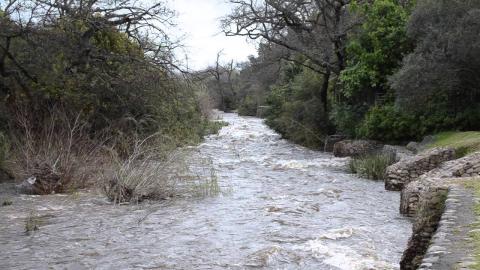The Beauty of Violence and Redemption Displayed in Baptism
April 25, 2023
1 comment
136 views

The river is high. Where it was once a gentle-flowing, shallow stream just days ago, the Eerste is now a rushing river. I’m struck by just how fast and violent the flow is this morning as I make my way across the bridge to the café. I'm reminded of why there are signs warning people to stay out of the water; these waters can be dangerous.
Much like the rushing waters of the Eerste, baptism, too, can be dangerous. Baptism is a violent act of God; violent towards sin, death, and the evil one. Being plunged under the waters serves as a sign of the drowning of the old Adam and our burial with Christ in His death.
In a visually visceral way, it is a recognition for the church that as Christians we are called to die to sin and self. Far from simply being a celebratory symbol of our obedience to God or a cute cultural rite passed down from one generation to the next, stepping into the waters is serious business and should not be done lightly.
And yet, as much as baptism is a violent act of God, a judgment against the sin and evil that signify death and destruction, it is also a sign of radical love and redemption, power and life. As the Belgic Confession reminds us, passing through the waters also serves as a sign of salvation sealed by Christ:
It [the blood of Christ] washes and cleanses us from [our] sins
and transforms us from being the children of wrath into the children of GodThis does not happen by the physical water
but by the sprinkling of the precious blood of the Son of God,
who is our Red Sea,
through which we must pass
to escape the tyranny of Pharaoh,
who is the devil,
and to enter the spiritual land of Canaan.Belgic Confession, Article 34
Baptism points to God’s violent judgment, but it also points to the glory of Christ’s redemptive work. Just as the Israelites passed through the Red Sea—finding redemption on the distant shore while Pharaoh’s army found death in the water—we find our redemption by passing through our own Red Sea—the person and work of Christ—to escape the evil one and enter into the people and Kingdom of God.
The waters of Christ—the sprinkling of His blood over us—cleanses, heals, and transforms. He brings new life. In baptism, we are received into the visible church, marked out from the rest of the world as people belonging to God. We are pointed to trust in Christ who is the way to that invisible Kingdom of God; a kingdom that has come, is coming, and will one day be consummated—invisible no more—so that all might see how great is our God.
Both of these ideas strike me today as I watch the foamy, flowing water as it passes beneath me. They strike me as I think of conversations about baptism with members of our church and look ahead to the possibility of some baptisms in the near future. The waters serve as a reminder of my own baptism, the calling I have received, and the sure hope of these promises sealed in me by Christ my Savior.
And both the waters of the Eerste and the waters of baptism remind me of how good and gracious our Father in heaven is, that He would give us such visible means for helping us understand the mysterious spiritual work He is doing in us, in His Church, and in all the world. Amen.
Faith Nurture
Faith Nurture
Faith Nurture
Connect to The Network and add your own question, blog, resource, or job.
Add Your Post
Comments
The title of this article is not sensitive to the growing number of victims of violence. There is no beauty in violence.... God transforms violence, and violence never thwarts His will, but please!
Let's Discuss
We love your comments! Thank you for helping us uphold the Community Guidelines to make this an encouraging and respectful community for everyone.